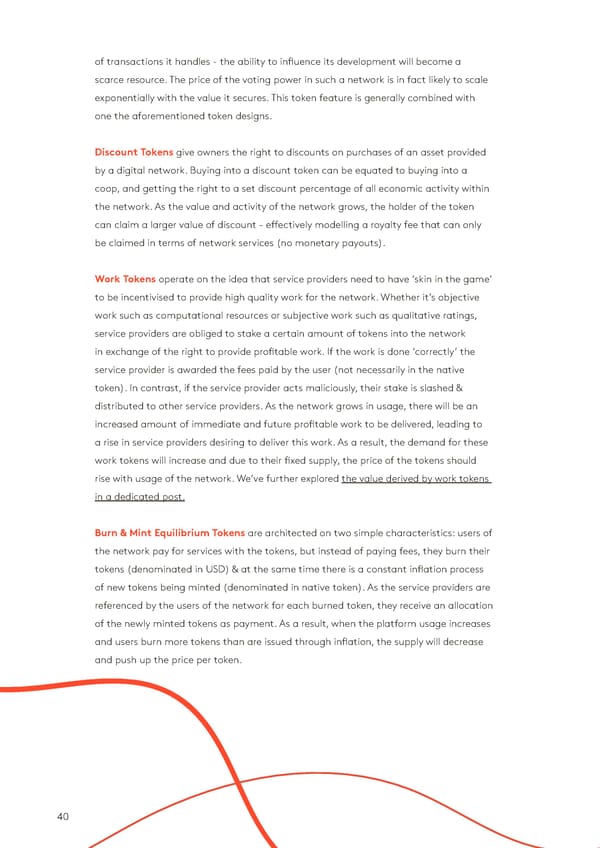of transactions it handles - the ability to influence its development will become a What’s at Stake for Investors scarce resource. The price of the voting power in such a network is in fact likely to scale exponentially with the value it secures. This token feature is generally combined with one the aforementioned token designs. The role of an investor investing in this plethora of token models must evolve from a simple capital allocator to an active participant within the networks. From community Discount Tokens give owners the right to discounts on purchases of an asset provided building, to token engineering, to actively running nodes, to actively managing liquid by a digital network. Buying into a discount token can be equated to buying into a positions, venture capital funds active in this space will soon be required to become coop, and getting the right to a set discount percentage of all economic activity within operationally involved within networks. This fulfills their fiduciary duty to maximise the network. As the value and activity of the network grows, the holder of the token the financial return on capital for their LPs, and also helps bootstrap the networks in can claim a larger value of discount - effectively modelling a royalty fee that can only which they are invested. Ambitious founders who understand that the path to enduring be claimed in terms of network services (no monetary payouts). success will be one of twists and turns will initially turn towards patient institutional partners, that inject both capital and work into their networks, and only once the Work Tokens operate on the idea that service providers need to have ‘skin in the game’ networks are live with a minimum viable number of nodes, will they start attracting to be incentivised to provide high quality work for the network. Whether it’s objective specific user groups or other relevant stakeholders through targeted sales or air-drops of work such as computational resources or subjective work such as qualitative ratings, tokens. service providers are obliged to stake a certain amount of tokens into the network in exchange of the right to provide profitable work. If the work is done ‘correctly’ the The most active investors will continuously engage with networks on multiple fronts over service provider is awarded the fees paid by the user (not necessarily in the native the duration of their investment: token). In contrast, if the service provider acts maliciously, their stake is slashed & Staking: As Proof of Stake (PoS) or Delegated Proof of Stake (DPoS) networks go live distributed to other service providers. As the network grows in usage, there will be an on mainnet, token holders will have the ability to stake their tokens in order to provide increased amount of immediate and future profitable work to be delivered, leading to profitable work to the network (validating transactions, computing, arbitration, a rise in service providers desiring to deliver this work. As a result, the demand for these transcoding or providing security) and be rewarded by the network (e.g. block rewards) work tokens will increase and due to their fixed supply, the price of the tokens should or by the users (e.g. transaction fees). In DPoS networks, operators within the network rise with usage of the network. We’ve further explored the value derived by work tokens can do the work as a service for a share of payouts, and token holders can delegate/ in a dedicated post. bond their tokens to the operators. Voting: Numerous networks are using their tokens as a governance tool - whether Burn & Mint Equilibrium Tokens are architected on two simple characteristics: users of through simple token voting, quadratic voting or liquid democracy, the tokens give a the network pay for services with the tokens, but instead of paying fees, they burn their voice to their holders. Long term investors will participate in the governance process of tokens (denominated in USD) & at the same time there is a constant inflation process the network, and steer it in the direction of their best interest. of new tokens being minted (denominated in native token). As the service providers are Curating: With Token Curated Registries (TCR), early investors in such networks will referenced by the users of the network for each burned token, they receive an allocation need to actively participate in the curation process, simultaneously keeping the registry of the newly minted tokens as payment. As a result, when the platform usage increases at high quality, as well as signalling the quality of curators involved. and users burn more tokens than are issued through inflation, the supply will decrease Running Nodes & Simple Usage of Network: As investors might also be users of and push up the price per token. networks, they might actively build early iterations of use-cases for the networks. From running nodes within the network for their own data-driven tracking purposes to actively participating within the network’s economy (e.g. buying services/assets), these investors will initially seed the ecosystems built on top of the networks. Beyond simply committing to actively participate in portfolio networks, Fabric has already begun setting up the infrastructure within certain testnets. Some of our early experiments of running nodes within the Ocean Protocol testnet are documented in a dedicated blog post. 40 41
 State of the Token Market Page 39 Page 41
State of the Token Market Page 39 Page 41